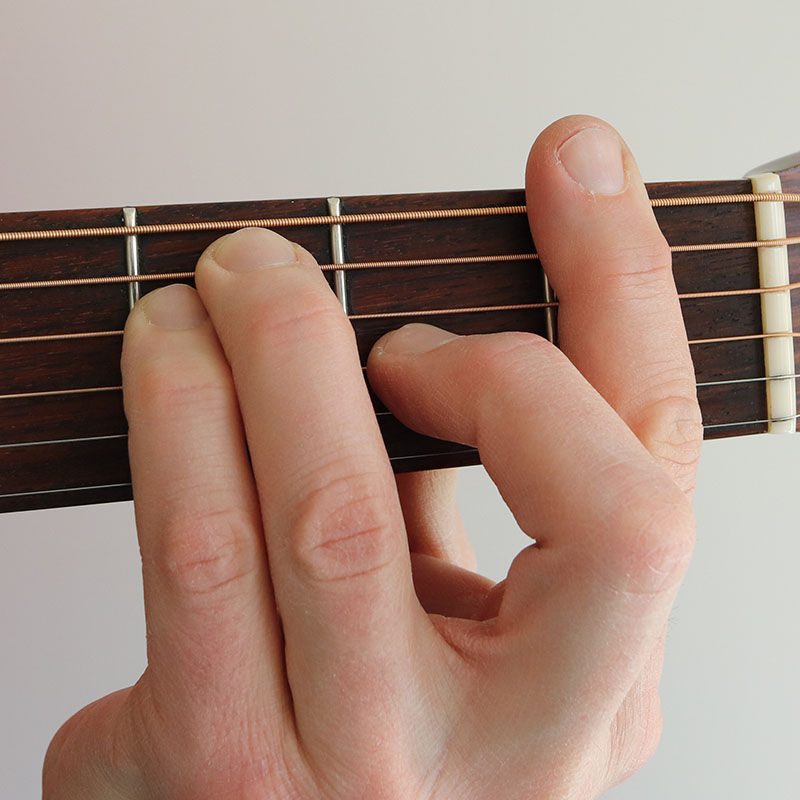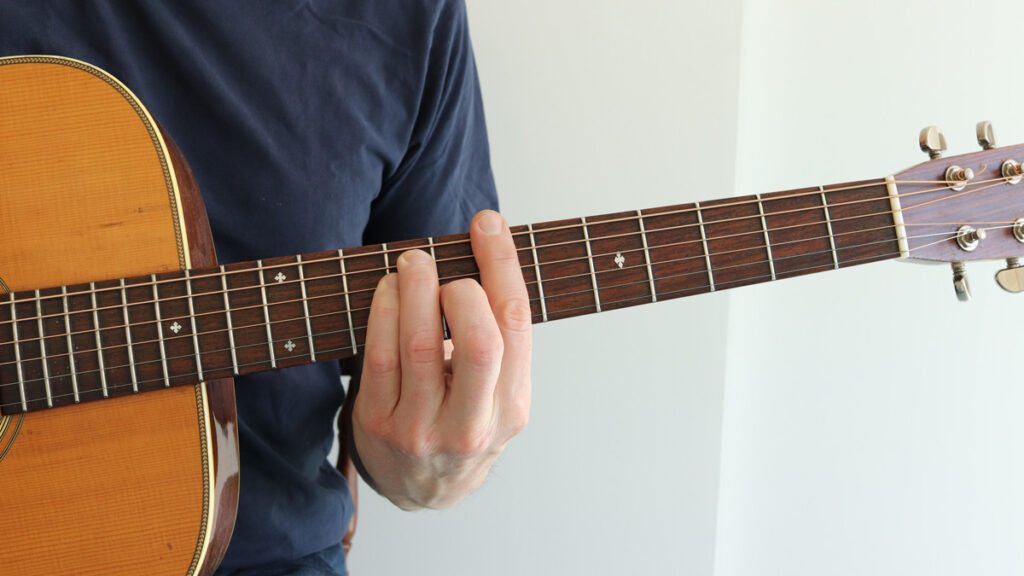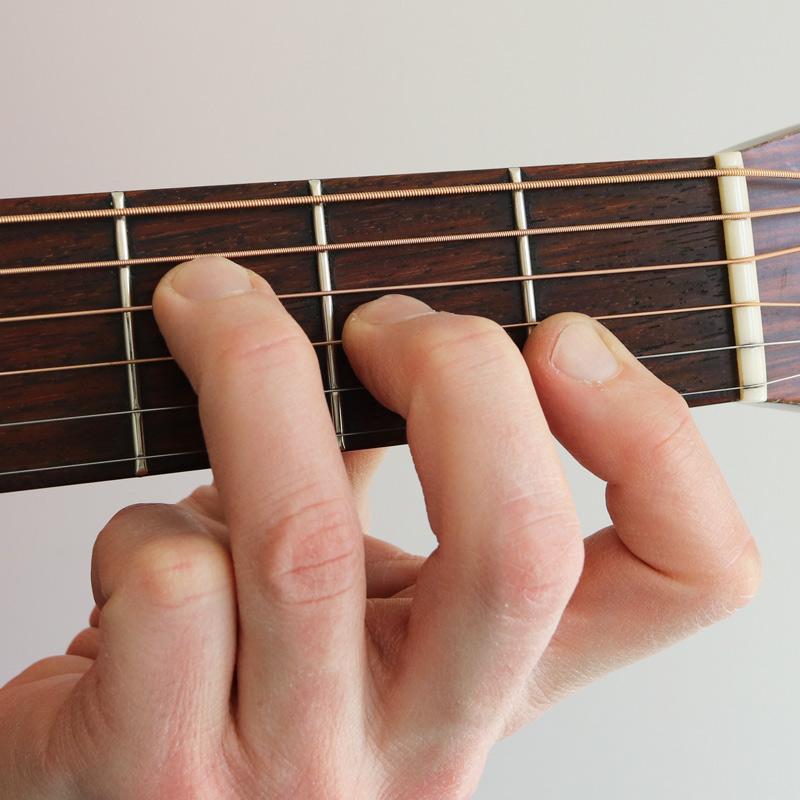Of all the basic major and minor chords that a beginning guitarist needs to learn, the hardest is probably F major. This is because, to play the full six-string version of the chord, you have to play a barre chord that spans all six strings. And what’s more, you have to play it on the 1st fret, where the string tension is higher than elsewhere on the fretboard. So it’s usually harder to press the strings onto the frets in that position.
But F major is also a really important chord because, if you can play it, you can play any other major chord just by moving the same shape to a different fret. That’s what so great about barre chords, which I explain in detail in the How to Play Barre Chords lesson. You should definitely read that lesson also because I go into more depth about barre chord technique, and all of that information applies 100% to the F chord that we’ll see in this lesson. So make sure to read both lessons before you start practicing this chord.
Fingering the F Major Chord
First, we’re going to look at the six-string version of the F major chord, which is commonly used for strumming a full, rich-sounding chord. But this is also tough to play at first, so I’ll also show you two variations that should be a little easier to pick up in the beginning.
To play F major, use your first finger to barre all six strings on the 1st fret. Then add your 2nd, 3rd, and 4th fingers on the A, D, and G strings, as shown in the diagram and photo. (Or, you can press down with your 2nd, 3rd, and 4th fingers first, and then add the barre with your 1st finger; it doesn’t matter what order you do it in.) Keep in mind that you want to lay your 1st finger flat against the fretboard, but you want to play with the tips of your other three fingers.
To play this chord correctly, you need to make sure your thumb is in the correct position behind the neck, and your elbow is down low enough toward the ground. Read more about that here to see what I’m talking about because it’s really important. Seriously!
Making it Sound Good
With this chord shape, the biggest challenge is usually getting the notes on the 1st and 2nd strings (played by the 1st finger) to ring out cleanly. There are two common obstacles to this: The first is that your other fingers (especially your 3rd/middle finger) might be getting in the way. This can happen if you’re not playing with the tips of your fingers or if your 3rd finger is hitting the fretboard at too shallow of an angle.
The other obstacle is the difficulty of pressing down your 1st-finger barre with enough pressure to hear the notes without buzz. It takes quite a bit of hand strength to press that part of your finger (the part closest to your hand) down onto the fretboard hard enough. And it’s especially hard on the 1st fret, where the strings are right next to the nut and the string tension is relatively high. Also, the frets are farther away from each other near the 1st fret than they are higher up the neck.
If you try to play the same exact chord shape on the 5th or 7th fret, instead of the 1st fret, I think you’ll find it much easier. So if you’re struggling with this, I suggest trying to get the chord working on a higher fret first before moving the whole thing to the 1st fret. So, for example, instead of barring the 1st fret, barre the 5th fret. And instead of putting your other fingers on the 2nd and 3rd frets, put them on the 6th and 7th frets. Once you can get the chord to sound clean there, you can move it down, trying it out on each fret until you get to the 1st fret.
“E-Shape” Barre Chords
The reason this chord is so important is that it’s usually the first “E-shape” barre chord that beginners encounter. Once you can play this chord, you can easily move it up and down the neck to play any other major chord. (And you can easily modify it to play a minor chord.) This section of the barre chords lesson shows the sequence of taking an open E chord and transforming it into a barre chord. (And if you’ve already seen the lesson on the B major chord, you’ll note the same process for that chord and “A-shape” barre chords.)
F Major Chord Variation
One version of the F chord that you should also learn involves playing a “partial-barre” instead of a full barre. This version is easier and is usually taught before learning the full barre shape. However, it’s not a great substitute for the full version when it comes to strumming along with other full chords. This is because it’s missing the notes on the lowest two strings and so is not as full sounding. But it’s a common, movable chord shape and you should still learn how to play it.
To play this chord shape, barre the first and second strings with your 1st finger. Make sure your thumb is behind the neck, just as if you were playing the full barre chord. Your 2nd finger then plays the second fret of the G string and your 3rd finger plays the third fret of the D string:
Practice
This one will take some practice but, believe me, it will be worth it. Mastering this chord shape is, in my opinion, the end of the “beginner chord” phase. When you can play this chord and the ten other beginner chords (E, E minor, A, A minor, D, D minor, B, B minor, G, and C), you’ll have reached a new level in your playing. From that point on, learning new chord shapes will come a lot easier and you’ll quickly expand your knowledge of chords all over the guitar neck.
The fundamentals of practicing this chord are the same as any new chord: After you finger the chord, play each note one at a time and make sure each one sounds clear. If it doesn’t, troubleshoot what’s going on. It’s usually a case of (1) incorrect thumb/hand position, (2) not pressing down hard enough, or (3) another finger getting in the way. If you get stuck, review the Em lesson and the How to Hold the Guitar lesson for tips on technique fundamentals. And, as with all barre chords, don’t overdo it to the point where your hand is cramping up. A little bit of practice every day is the key to success. Good luck!







Thank you. Because of work and family commitments I don’t have time to commit to a guitar course. So, I appreciate you putting up the information you have. It allows me to learn about the guitar at my pace. I also really appreciate you identifying the first ten beginner chords as well as the fact that the F major chord is the gateway to playing the other major chords.
Thank you again.
Thanks for the feedback–I’m so glad you found it helpful. I stepped away from the website for a long time but I’m now in the process of making more videos and lessons, so let me know if there are specific topics you’re interested in. Good luck and keep playing!